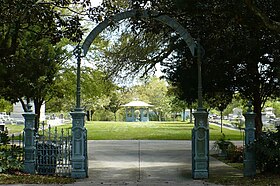
Mobile is a city and the county seat of Mobile County, Alabama, United States. The population within the city limits was 187,041 at the 2020 census, down from 195,111 at the 2010 census. After a successful vote to annex areas west of the city limits in July 2023, Mobile's population increased to 204,689 residents. It is now the second-most-populous city in Alabama, after Huntsville.

Oakland Cemetery is one of the largest cemetery green spaces in Atlanta, Georgia, U.S. Founded as Atlanta Cemetery in 1850 on six acres (2.4 hectares) of land southeast of the city, it was renamed in 1872 to reflect the large number of oak and magnolia trees growing in the area. By that time, the city had grown and the cemetery had enlarged correspondingly to the current 48 acres (190,000 m2). Since then, Atlanta has continued to expand so that the cemetery is now located in the center of the city. Oakland is an excellent example of a Victorian-style cemetery, and reflects the "garden cemetery" movement started and exemplified by Mount Auburn Cemetery in Massachusetts.

Mobile National Cemetery is a United States National Cemetery located in the city of Mobile, Alabama. It encompasses 5.2 acres (2.1 ha), and as of the end of 2005, had 5,326 interments. It is an annex to the larger Magnolia Cemetery. Mobile National Cemetery is administered by Barrancas National Cemetery in Pensacola, Florida, and is currently closed to new interments.

Congregation B'nai Israel is a Reform Jewish congregation and synagogue located in Galveston, Texas, in the United States. Organized by German Jewish immigrants in 1868, it is the oldest Reform congregation and the second chartered Jewish congregation in the state.

Magnolia Cemetery is a historic city cemetery located in Mobile, Alabama. Filled with many elaborate Victorian-era monuments, it spans more than 100 acres (40 ha). It served as Mobile's primary, and almost exclusive, burial place during the 19th century. It is the final resting place for many of Mobile's 19th- and early 20th-century citizens. The cemetery is roughly bounded by Frye Street to the north, Gayle Street to the east, and Ann Street to the west. Virginia Street originally formed the southern border before the cemetery was expanded and now cuts east–west through the center of the cemetery. Magnolia contains more than 80,000 burials and remains an active, though very limited, burial site today.

Catholic Cemetery, formerly known as the Stone Street Cemetery, is a historic 150-acre (61 ha) cemetery located in Mobile, Alabama. It was established in 1848 by Michael Portier, a native of Montbrison, France and the first Roman Catholic Bishop of Mobile. The cemetery contains roughly 18,000 burials and has plots dedicated to various Roman Catholic religious institutes, including the Brothers of the Sacred Heart, Daughters of Charity, Little Sisters of the Poor, and Sisters of Mercy. It was placed on the National Register of Historic Places on July 3, 1991, as a part of the Historic Roman Catholic Properties in Mobile Multiple Property Submission.

Ahavas Chesed Cemetery, is a historic Jewish cemetery located in Mobile, Alabama. It was established by the Ahavas Chesed congregation in 1898. It covers about 2 acres (0.81 ha) of land in a narrow strip that adjoins the Sha'arai Shomayim Cemetery.

Congregation Sha'arai Shomayim, is a Reform Jewish congregation and synagogue, located at 1769 Springhill Avenue, in Mobile, Alabama, in the United States. Organized in 1844, it is the oldest Jewish congregation in Alabama, and one of the oldest in the United States. The current synagogue for the congregation is the Springhill Avenue Temple.
Shaarey Shomayim or Shaarei/ShaarayShamayim/Shomoyim may refer to the following Jewish synagogues:

Congregation Beth Israel is a Reform Jewish congregation and synagogue located at 5600 North Braeswood Boulevard, in Houston, Texas, in the United States. The congregation, founded in 1854, is the oldest Jewish congregation in Texas; and it operates the Shlenker School.

Temple Israel is a Reform Jewish congregation and synagogue, located at 130 Riverside Drive in Dayton, Ohio, in the United States.

Congregation Beth Israel is a Reform Jewish congregation and synagogue, located in Meridian, Mississippi, in the United States. Founded in 1868 and a member of the Union for Reform Judaism, the congregation's first permanent house of worship was a Middle Eastern-style building constructed in 1879. The congregation moved to another building built in the Greek Revival style in 1906, and in 1964 moved to a more modern building, out of which they still operate.
Temple Beth Or, founded as Kahl Montgomery, is an historic Reform Jewish congregation and synagogue located at 2246 Narrow Lane Road, in the Cloverdale neighborhood of Montgomery, Alabama, in the United States.
The Jewish American Society for Historic Preservation (JASHP) is an American non-profit 501(c)(3) volunteer historical society. The society locates sites of American and Jewish historical interest and importance. It works with local community organizations, synagogues, churches, historical societies, governments and individuals, to erect interpretive historical markers that help illuminate the American-Jewish experience and reflect on the commonality of being American.

Temple B'nai Sholom is an historic Reform Jewish congregation and synagogue, located at 103 Lincoln Street SE, in Huntsville, Alabama, in the United States. Founded as a congregation on July 30, 1876, the current synagogue building was dedicated on November 26, 1899. It is the oldest synagogue building in continuous use in the state.
Alfred Geiger Moses (1878–1956) was an American rabbi associated with Reform Judaism and the founder of Jewish Science, a Jewish spiritual movement comparable with the New Thought Movement and viewed as supplementing services at conventional synagogues.


















